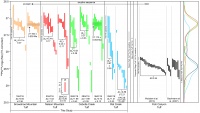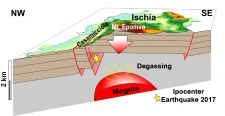ERC Starting Grant Fever
500 million people live in proximity of volcanoes and eruptions have a significant social and economical impact, thus forecasting the recurrence rate of volcanic eruption remains a great challenge in science. The target of FEVER is to produce a physically based statistical model able to ForEcast the recurrence rate of Volcanic ERuptions both at regional and global scale. What are the processes that control the size and frequency of volcanism at an individual, regional and global scale? Using a range of geochemical and statistical techniques FEVER tackles this question.
NEWS
Determining the State of Activity of Transcrustal Magmatic Systems and Their Volcanoes published on Annual Review of Earth and Planetary Sciences – January 2022
We review the processes associated with the temporal evolution of transcrustal volcanic plumbing systems and their impact on the potential magnitude of future volcanic eruption. We define a Volcanic Activity Index, which by comparing all volcanoes for which data exist, allows to define, on the base of the geological record, the likelihood of single volcanoes to erupt in the future.
Machine learning thermobarometry and chemometry using amphibole and clinopyroxene: a window into the roots of an arc volcano (Mount Liamuiga, Saint Kitts) published on Contributions to Mineralogy and Petrology – December 2021
We use machine learning thermometry to identify a remarkable increase of temperature in time throughout the stratigraphy on Saint Kitts. This reflected thermal rejuvenation of the system following the opening large- volume eruption. This contribution improves our understanding of the inherent decoupling between various geochemical signals, namely bulk rock and mineral chemistry.
Classification, segmentation and correlation of zoned minerals published on Computers & Geosciences – November 2021
This contribution shows a new method to statistically classify, segment and correlate zoned magmatic crystals using quantified chemical maps. This has previously proved challenging via an array of other approaches.
Quantitative chemical mapping of plagioclase as a tool for the interpretation of volcanic stratigraphy: an example from Saint Kitts, Lesser Antilles published on Bulletin of Volcanology – July 2021
We applied the new crystal segmentation algorithm to quantitatively link petrology and volcanology. We numerically described the presence (and absence) of crystal populations in time and identified a relationship between crystal zoning complexity and eruption magnitude. Such geochemical fingerprints may even hint as to the impending end to an eruptive cycle on Saint Kitts due to the progressively increasing proportions of certain crystal populations.
The build-up and triggers of volcanic eruptions published on Nature Reviews Earth & Environment – June 2021
In this article we review the processes associated with the assembly of volcanic plumbing systems and the potential mechanisms responsible for the initiation, migration, and eruption of magma at the surface.

Timescales and thermal evolution of large silicic magma reservoirs during an ignimbrite flare-up: perspectives from zircon. Published on Contributions to Mineralogy and Petrology – November 2021
Paper published in Journal of Petrology - January 2021
We used thermobarometry, trace element modelling, and mineral chemistry to understand the geometry and evolution of the magma reservoirs responsible for one of the most rapid and voluminous ignimbrite flare-ups in the world: last four ignimbrite eruptions of the central San Juan caldera cluster, Colorado. We found 1) a complex crustal architecture of magma reservoirs similar to that beneath the Altiplano Puna Volcanic Complex and 2) previously unknown petrologic distinctions between zoned and unzoned ignimbrites. This research also suggests that thermal rejuvenation is not a universal mechanism for triggering the largest ignimbrite eruptions on Earth.
Thermal inversion method of zircon crystals published in Nature Communications – November 2020
We have developed a new method that allows to estimate the volume of magma stored below volcanoes and provides essential information about the potential size of future eruptions. The method combines numerical models of magmatic systems with the extraordinary temperature and timekeeping abilities of zircon crystals. Our method opens the possibility to survey the destructive potential of volcanoes.
Paper published in Frontiers in Earth Sciences – September 2020
Neighboring stratovolcanoes often show distinct preferences in the most commonly erupted magma type and therefore pose different hazards. Using geochemistry and numerical modelling, we show that such differences are primordial, persistent and governed by differences in recharge magma types.
Research published in Scientific Reports - July 2020
Some volcanoes erupt a large range of magma types (e.g. Santorini), while others produce the same magma composition throughout their lifetime (e.g. Merapi). Our research employing numerical models shows that this contrasting behavior can be explained by different magma injection regimes and thermal conditions of the Earth crust.
New paper in Frontiers in Earth Sciences - May 2020
We use graphical models called bayesian networks to investigate the probabilistic relationships between regional tectonic parameters and the sizes of large explosive events in the volcanic eruption record. This allows us to compare different volcanic arcs and explore the possible processes that control the accumulation and eruption of magma on Earth.
New paper in Frontiers in Earth Sciences - March 2020
We use a machine learning approach to identify the relationships between the chemical complexity of clinopyroxene crystals and the thermal evolution of the plumbing system for the 2014-2015 Holuhraun-Bardarbunga eruption.
Research published in Geophysical Research Letters - December 2019
In a multidisciplinary study involving the "Istituto Nazionale di Geopfisica e Vulcanologia" (INGV, Italy) and the University of Roma Tre, we show that the cause of the deadly earthquakes at Ischia, the last of which occurred in 2017, is linked to magma degassing. This study also show that the seismicity at Ischia will continue for centuries.
At this year’s Swiss Geoscience Meeting in Fribourg, our master student Corin Jorgenson was awarded the price for the best poster.

Research published in Journal of Geophysical Research: Solid Earth - October 2019
Using chemical analysis of mineral zoning profiles and diffusion modelling, we were able to track the sequence of magmatic events and timescales prior to Plinian eruptions from Nevado de Toluca volcano in Central Mexico. Such information is critical in order to evaluate the timing and nature of monitoring signals that could emerge before to an explosive eruption in this densely populated area.

Oliver Higgins won an early Career Researcher award for the best presentation and the VoiLA workshop in Trinidad - September 2019
Oliver Higgins won an Early Career Researcher Award from Nature Communications for giving the best talk at the Volatiles in the Lesser Antilles workshop (Trinidad) in September 2019. This was presenting his PhD study which focusses on the magmatic system on St Kitts, Lesser Antilles.

New paper in Contributions to Mineralogy and Petrology - March 2019
Geochemical and structural data from the Murato sill in Japan, combined with thermal modelling, enabled us to quantify extraction timescales and the range of crystallinity at which melt extraction occurred. These results improve the understanding of the dynamics of melt accumulation in magmatic bodies.

St Kitts fieldwork - January/February 2019
Ollie, Tom & Luca spent two weeks on the volcanic island of St Kitts in the Caribbean as part of Ollie's PhD project. They collected samples to analyse back in Geneva and characterised the stratigraphy of the volcanic deposits exposed along the Atlantic coastline.
New Paper in EPSL - January 2019
Understanding the role of H20 on the extraction of residual melts from crystalline magmas. In this study we address the effect of magma water content on the distribution and volume of crystal-poor and eruptible magma that can be extracted from crystallising magma reservoirs.
Southern Rocky Mountains Fieldwork - August 2018
Adam and Greg visited the USA for a second campaign in Adam's field area. They were there to collect more samples to help constrain the processes that led to a sequence of three ignimbrite-forming eruptions.
Research published in Earth and Planetary Science Letters - April 2018
Exploring the physical and chemical changes in magmatic systems resulting from flushing of CO2.
Volcanology outreach - March 2018
Introducing volcanology to the youthful readership of Frontiers for Young Minds: Does the shape of a volcano reflect it's personality?
New paper in Contributions to Mineralogy and Petrology - February 2018
How to quantify if crystals share similar histories or experience similar processes? This research presents a methodology to correlate profiles of chemical zonation within magmatic crystals.
Mexico fieldwork - January 2018
Greg, Adam and Luca visited Mexico to perform a second sampling campaign on Nevado de Toluca. Greg also presented his research at Instituto de Geología UNAM, Mexico City. You can see his presentation by clicking on the picture to the left.
New paper in Nature Geoscience - September 2017
New research indicates sea level changes associated with the Messinian Salinity Crisis lead to increased volcanism in the Mediterranean region.

IAVCEI - Portland - August 2017
We just came back from a successful volcanology conference where we gave 6 talks and 3 posters on various aspects of our research.
New paper in the Journal of Petrology - April 2017
The Takidani pluton shows evidences of extraction of residual melt from crystallising magma and textures produced by the pressure drop associated with volcanic eruptions.

























